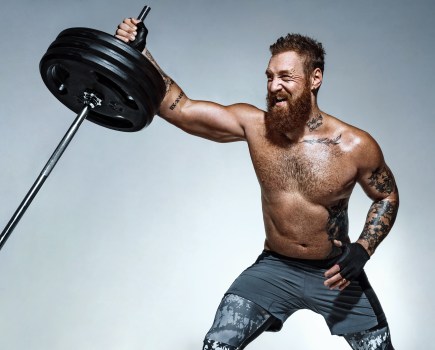An effective training program should cover all five measurable health and wellbeing components: strength, work capacity (cardio fitness), mobility, body composition and emotional wellbeing. Just like foam rollers, stretching exercises fall under the banner of mobility, and this is a component you can’t afford to ignore this new year if you want to get the best results from your workouts.
How to get started with these stretching exercises
The best stretching exercises can be performed as a standalone session, or as a dynamic warm-up before strength training.
If performing as a standalone session, aim to work through them as a continuous circuit – with 4 complete circuits your target. Or, if performing these stretches as a dynamic warm-up, the intent should be to move swiftly from one exercise to the next, therefore helping to elevate the heart rate as you mobilise your whole body.
These stretches are a little more technically demanding than our stretching exercises for beginners, so they require more body awareness to perform.
Why you can trust the workouts in Men’s Fitness
At Men’s Fitness we pride ourselves on delivering information that serves a singular purpose: to improve some aspect of your health, fitness or wellbeing. For over 16 years, we’ve been publishing authoritative health and fitness content – written by our expert editors and contributors. Each of our workouts has been created and tested by either a highly experienced editor or expert contributor. These stretching exercises were suggested by renowned PT Luke Worthington.
Try these best stretching exercises
- Pigeon stretch (for hips and lower body)
- Spiderman stretch (for hips and lower body)
- Half-kneeling adductor dip stretch (for hips and lower body)
- Ankle hip lift (for ankles and hips)
- Caveman squat (for hips and spine)
- Thread the needle (for shoulders and back)
- Bird dog (for back and core)
- Supine twist (for spine and core)
These are the best lower-body stretches
Pigeon stretch
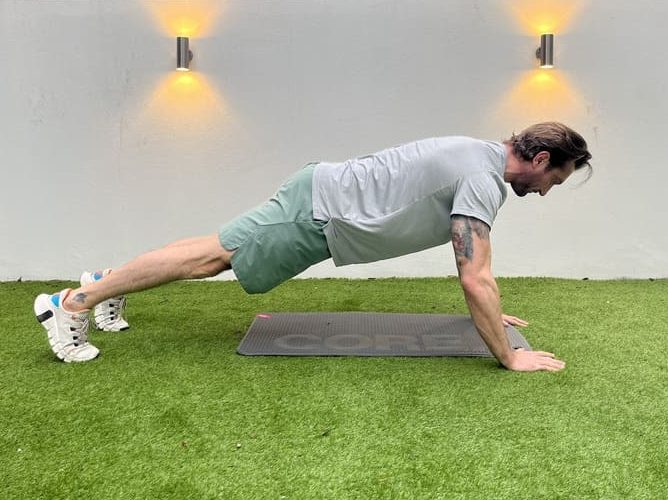
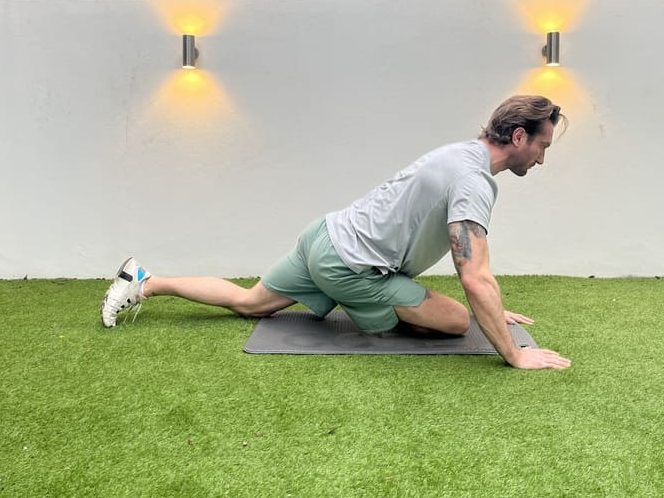
Hold: 30-60 secs each side
Why I like the pigeon stretch: This move stretches out the hip flexors, glutes and lower back.
How to do the pigeon stretch:
- Lie on a mat, with one leg bent and flat in front of you and the other leg stretched out straight behind you
- Once stable, bring the weight of your body down on your front leg and try to keep your hips square
- Relax there and breath into the stretch
- Once you’ve hit 30 secs or more, slowly bring yourself back up and repeat on the other side
My pointers:
- Aim to get the knee and ankle both to the floor at the same time, with the shin as close as you can manage to being at 90 degrees to your body line
- Also, be sure to keep bracing the core to prevent extension of the lower back
Spiderman stretch
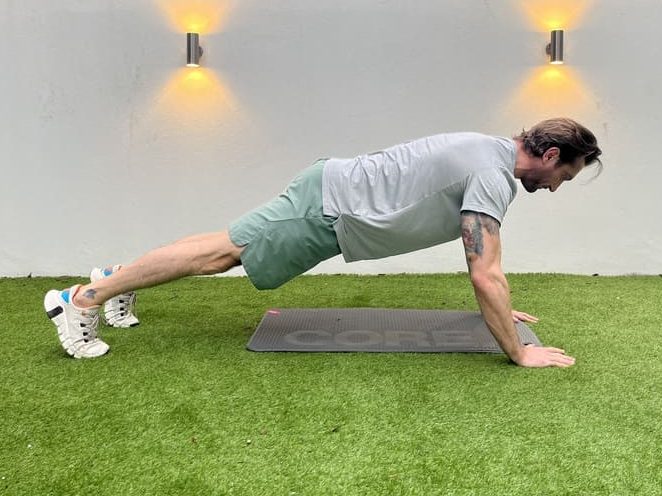
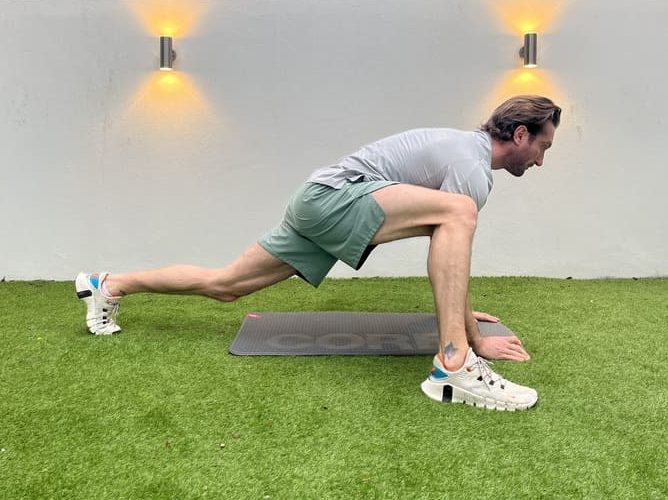
Reps: 6 each side
Why I like the Spiderman stretch: This is a great exercise for improving hip and hamstring flexibility.
How to do the Spiderman stretch:
- From a push-up position, bring one foot forward so it reaches the outside of the hand on the same side
- Lower the hip to increase the stretch
- Hold for 10-15 seconds each side
My pointers:
- The knee on the stepping foot should just brush against the outside of your shoulder on the same side
- Try to keep the back knee raised from the floor to allow a greater range at the hip
Half-kneeling adductor dip stretch
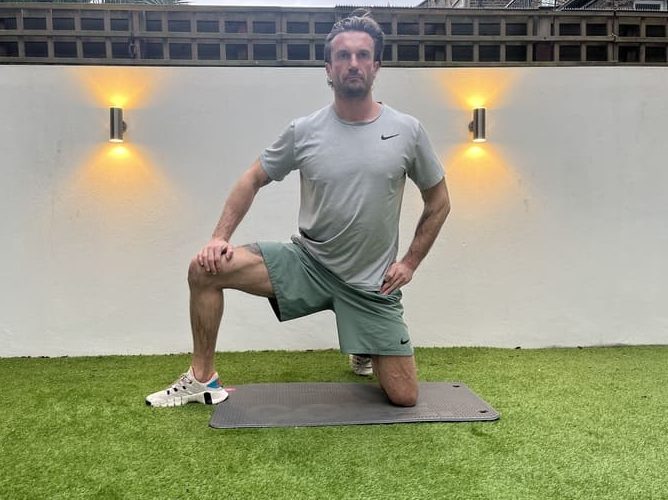
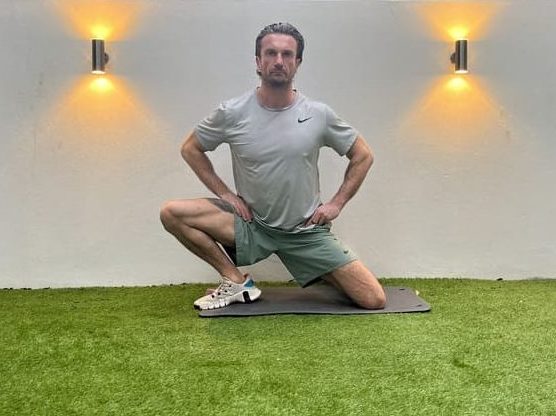
Reps: 8 each side
Why I like the adductor dip stretch: The groin area (adductors) is a dense area of muscle. For that reason, it’s often a source of injury and tightness. This is an excellent movement that will loosen everything up and help prevent injury.
How to do the adductor dip stretch:
- Assume a half kneeling position
- From here, ‘dip’ your non-kneeling leg down to the side until you feel a good stretch
- Hold for a count, then return to half kneeling
- Repeat for 8 reps on one side, then switch
My pointers:
- Aim for 90° angles at both knees, with the weight centred over the knee on the floor
- Also, keep the torso as upright as possible as you dip – this ensures length in the adductors
Ankle hip lift

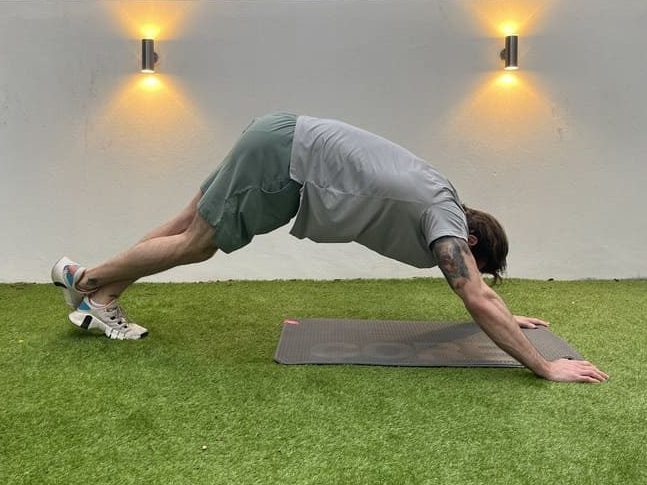
Reps: 10 each side
Why I like the ankle hip lift: This is a great move for improving ankle mobility, which is essential for effective squatting.
How to do the ankle hip lift:
- Assume a push-up position
- Now lift one foot and place it over the heel of the other
- Now push your hips back – as if getting into a downward dog – press your grounded ankle towards the floor as far as it will go
- Return to the starting position, then repeat for a total of 10 reps
My pointers:
- Use the weight of the non-working leg to assist with pressing the heel to the floor as you lift your hips
- Ensure the core stays braced to avoid extension of the lower back
Caveman squat stretch
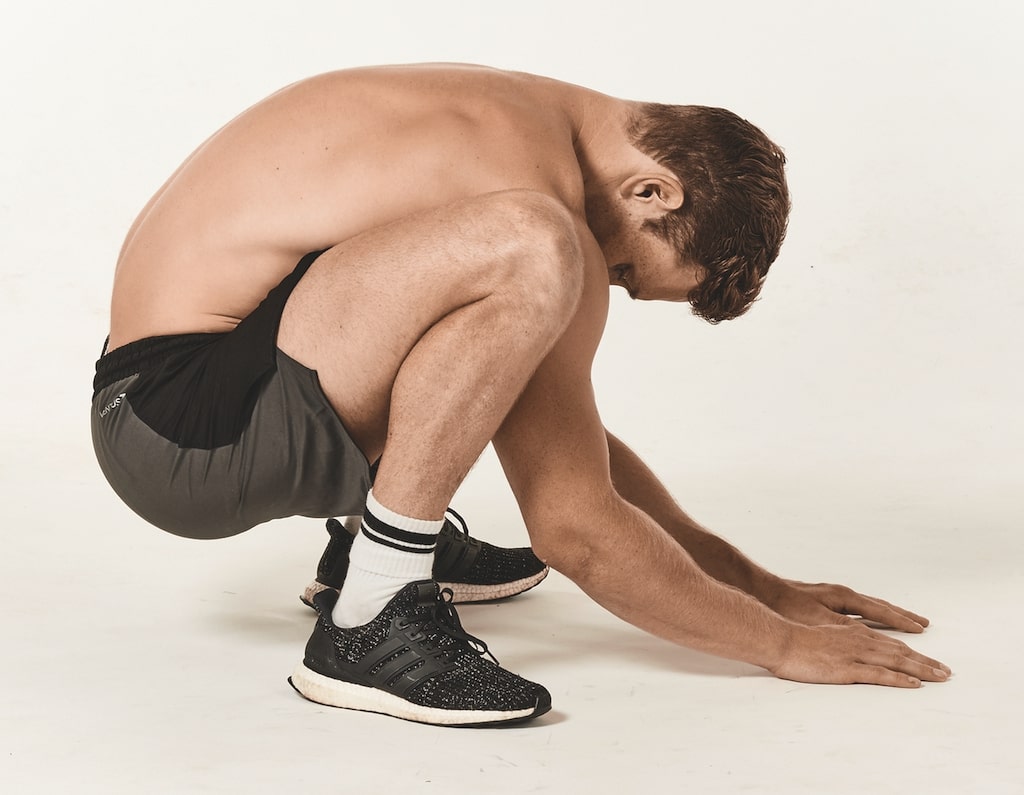
Hold: 45-60 secs
Why I like the caveman squat stretch: It stretches out the spine while encouraging a deep squat, opening up the hips.
How to do the caveman squat stretch:
- With your feet shoulder-width apart, toes turned out slightly and feet completely flat on the floor (heels down), squat down to the ground as deep as you can go
- Keep your weight even in your feet and tuck your chin into your chest
- If you can’t do this because your calves and hips are too tight, grab a bench and use this as an anchor instead
My pointers:
- If you lack the ankle and/or hip mobility to get into a deep squat (with heels on floor) as pictured, hold onto a stable object in front of you to begin with
- As your ankle and hip mobility improves, gradually support yourself less and less with the object in front
These are the best upper-body stretches
Thread the needle


Reps: 8 each side
Why I like thread the needle: This move releases tension across the entire upper body, while improving thoracic mobility.
How to do thread the needle:
- Begin on your hands and knees in ‘tabletop pose’
- Slide your left arm underneath your right arm with your palm facing up
- Let your left shoulder come all the way down to the mat. Rest your left ear and cheek on the mat, then gaze toward your right
- Relax your lower back
- Hold for a count, then return to the start and repeat for a total of 8 reps
My pointers:
- Ensure you rock the hips back on to your heels before initiating the rotation. This keeps the movement in the upper back
- The gaze should follow the fingertips of the moving arm, so you should end up looking under your armpit
Bird dog
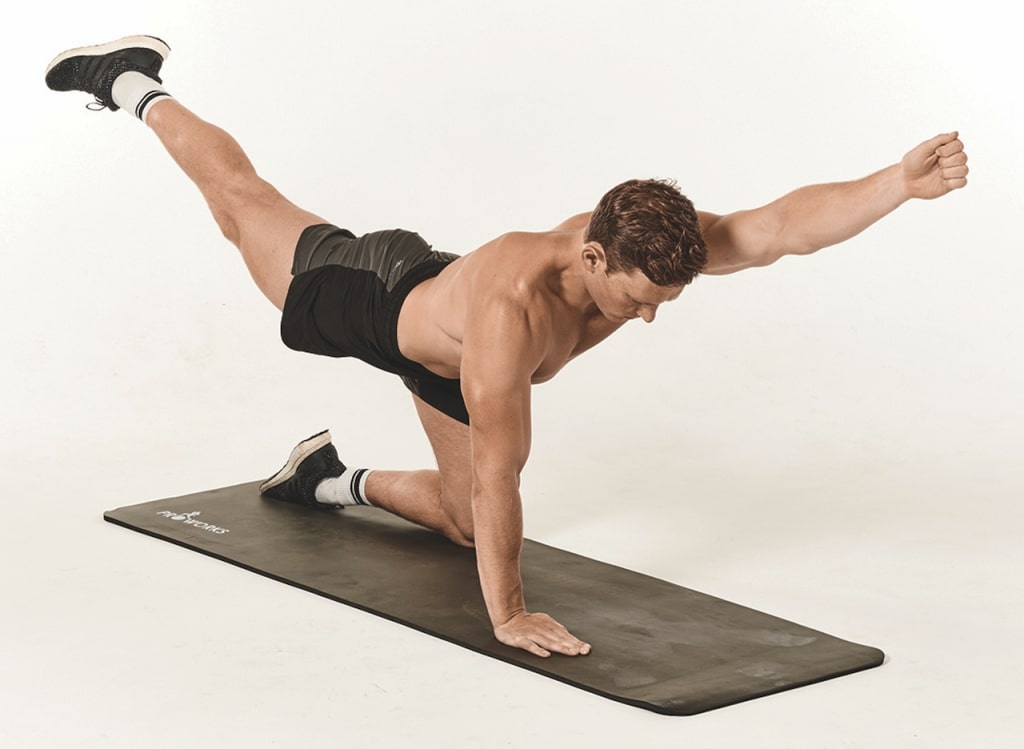
Reps: 10 each side
Why I like the bird dog: Relieves lower back pain, while improving core and spinal stability.
How to do the bird dog:
- Assume an ‘all fours’ position on the floor. Lift one hand and the opposite knee off the ground slightly
- Touch your elbow and knee underneath you and then explosively donkey kick the heel backwards and punch the arm out in front
- Slowly connect them underneath you again and repeat the process for the desired reps
- Change sides
My pointers:
- The aim of this pose to stay as stable as possible. Keep your hips still and avoid sideways rotation
Supine twist
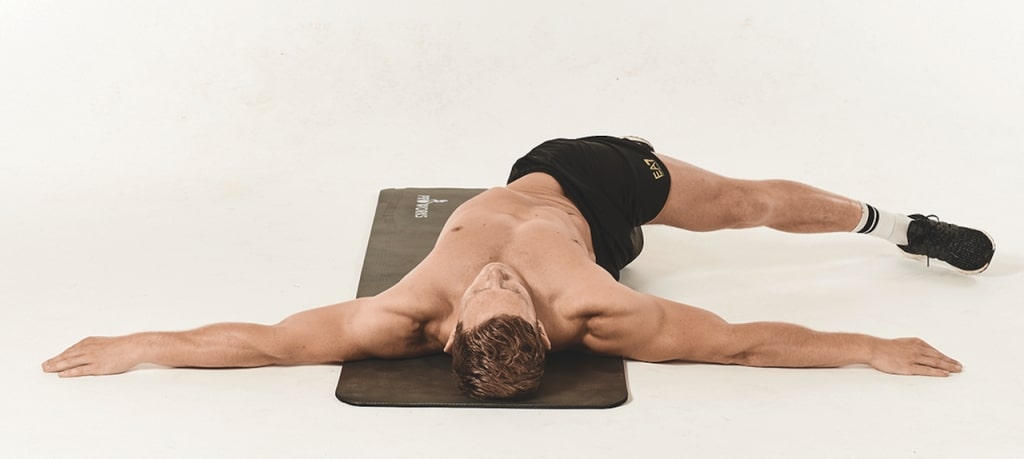
Reps: 20 each side
Why I like the supine twist: Improves spinal flexibility, loosens the lower back, lengthens external hip rotators and aids digestion.
How to do the supine twist:
- Lie flat with your arms out to your side (palms down). Lift one leg in the air, keeping it reasonably straight, then drop your leg across your body and down to the ground
- Keeping the opposite shoulder as close to the ground as you can, return the leg to the start position and do the same with the other leg. That’s 2 reps
My pointers:
- Do not force your knee towards the floor. Bring it over only as far as your mobility allows
- Keep your shoulders glued to the floor, even if it means your knee can’t reach very far to the side
Benefits of stretching exercises
So, why are stretches so important? Maintaining the ability to move through a full range of motion will not only reduce your risk of injury, but also ensure you’re maximising both muscle and strength progressions.
Our roundup of the best stretching exercises is designed to stabilise the core and loosen the glutes, hip flexors, adductors, upper back and ankles. These are all areas commonly associated with stiffness. Equally, they’re all areas that will improve strength training performance if you can move them efficiently.
What equipment do I need for stretching exercises?
While many stretching exercises can be performed anytime, anywhere, without the need for any equipment, there are certain bits of kit that can improve your form and aid comfort.
For example, it’s recommended to perform any floor stretches on an exercise mat. This extra layer between you and the floor will provide some cushioning for a more comfortable stretching session. It can also help with grip too – crucial when you’re doing your stretches on a slippery wooden floor.
Alongside an exercise mat, you can also add certain props to your stretches, to support your body and improve your form. Yoga blocks, for example, are used to bring the floor closer to you during a stretch, helping you to achieve perfect form and alignment, even if your flexibility is limited.
We recommend trying the URBNFit Yoga Block, which is made from a soft, moisture-resistant material. The wide and grippy brick design means you can balance the block on any of its edges, depending on the height you require.
Related content:







